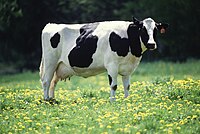
Photo from wikipedia
Reports on the effects of length of dry period (DP) on udder health of cows that were not treated with dry cow antibiotics are scarce. Additionally, the effects of a… Click to show full abstract
Reports on the effects of length of dry period (DP) on udder health of cows that were not treated with dry cow antibiotics are scarce. Additionally, the effects of a reduced dietary energy level for cows with a 0-d DP on udder health have not yet been studied. The aims of this study were (1) to compare effects of a 0-d or 30-d DP without use of dry cow antibiotics on udder health across the DP and subsequent lactation in dairy cows fed different dietary energy levels and (2) to evaluate associations between udder health and metabolic status of dairy cows. Five weeks before the expected calving date, Holstein-Friesian dairy cows (n = 115) were blocked for parity, expected calving date, and milk yield and somatic cell count (SCC) at their 2 last test days and were randomly assigned to 2 DP lengths: 0-d DP (n = 77) or 30-d DP (n = 38). Quarter milk samples were taken in wk 5 prepartum and in wk 1 and 5 postpartum. Proportion of quarters with elevated SCC (SCC ≥200,000 cells/mL) and proportion of udder pathogens in quarter milk samples did not differ between DP lengths among weeks. After calving, 102 of these cows were randomly assigned to 3 treatments: a 30-d DP with a standard energy level required for expected milk yield (30-d DP SEL; n = 36), a 0-d DP with the same energy level as cows with a 30-d DP (0-d DP SEL; n = 33), and a 0-d DP with a low energy level (0-d DP LEL, n = 33). From wk 8 of lactation onward, cows received either a glucogenic ration consisting of corn silage and grass silage or a lipogenic ration consisting of grass silage and sugar beet pulp at a standard or low energy level. During wk 1 to 7 postpartum, treatment did not affect SCC or SCC corrected for milk yield. During wk 8 to 44 of lactation, 0-d DP SEL cows had a greater SCC than 0-d DP LEL or 30-d DP SEL cows and had a greater SCC corrected for milk yield than 0-d DP LEL cows. During wk 1 to 44 of lactation, occurrence of at least 1 elevation of SCC (SCC ≥200,000 cells/mL after 2 wk of SCC <200,000 cells/mL) was not different among treatments. The 0-d DP SEL cows but not the 0-d DP LEL cows tended to have a 2.17 times greater hazard of having a case of clinical mastitis at any time in lactation than 30-d DP SEL cows. In wk 1 to 44 of lactation, lower fat- and protein- corrected milk yield and energy intake, greater energy balance, and greater plasma insulin concentration were associated with greater SCC. In conclusion, DP length did not affect udder health in the DP and in early lactation but seemed to decrease udder health for 0-d DP SEL cows in later lactation compared with 30-d DP SEL or 0-d DP LEL cows.
Journal Title: Journal of dairy science
Year Published: 2018
Link to full text (if available)
Share on Social Media: Sign Up to like & get
recommendations!